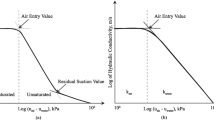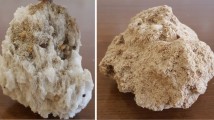Abstract
Evaporitic geology, hot and arid climate, fluctuating relative humidity, and an alkaline environment governed the evolution of sedimentary deposits in the Arabian Gulf coast. Calcium sulphate generally occurs as anhydrite in the unsaturated surface layer of local soil formations. Anhydrite hydrates to gypsum with an associated volume increase of up to 63%, whereas gypsum dehydration results in a reversal back to anhydrite that leads to 39% volume decrease. Swelling and compressibility problems are common in several coastal deposits of the globe. This paper investigates the geological and engineering aspects of anhydrite/gypsum transition in the Arabian Gulf coast. Oedometer test results on Dammam anhydrite were studied in conjunction with morphological assessments at critical volume change stages. Results indicated 10% swelling potential and 295 kPa swelling pressure for hydrating anhydrite. The compression index of anhydrite and gypsum were 0.067 and 0.12, respectively, whereas the rebound index of anhydrite was 0.023.
Résumé
Un contexte évaporitique, un climat chaud et sec, une humidité relative variable et un environnement alcalin ont contrôlé l’évolution des dépôts sédimentaires de la côte du Golfe arabique. Le sulfate de calcium se présente généralement sous forme d’anhydrite dans la couche supérieure non saturée des formations superficielles. L’anhydrite s’hydrate en gypse avec une augmentation de volume pouvant atteindre 63% tandis que la déshydratation du gypse conduit, à l’inverse, à l’anhydrite avec une diminution de volume de 39%. Les problèmes de gonflement et de compressibilité sont communs dans plusieurs régions côtières du monde. L’article étudie les aspects géologique et d’ingénierie des transformations anhydrite/gypse sur la côte du Golfe arabique. Les résultats d’essais oedométriques sur l’anhydrite de Damman ont été analysés, en conjonction avec des caractérisations morphologiques à différentes étapes de changement volumique. Les résultats ont montré un potentiel de gonflement de 10% et une pression de gonflement de 295 kPa pour l’anhydrite en cours d’hydratation. Les indices de compression de l’anhydrite et du gypse étaient respectivement de 0,067 et 0,12 tandis que l’indice de gonflement de l’anhydrite était de 0,023.








Similar content being viewed by others
References
Abduljauwad SN (1994) Swelling behavior of calcareous clays from the Eastern Province of Saudi Arabia. Q J Eng Geol 27:333–351
Al-Amoudi OSB, Abduljauwad SN (1995) Compressibility and collapse potential of an arid, saline sabkha soil. Eng Geol 39(3):185–202
Azam S (2000) Collapse and compressibility behavior of arid calcareous soil formations. Bull Eng Geol Environ 59(3):211–217
Bell FG (1993) Engineering geology. Blackwell, Oxford
Blatt H, Middleton G, Murray R (1980) Origin of sedimentary rocks, 2nd edn. Prentice-Hall, New York
Blount CW, Dickson FW (1973) Gypsum–anhydrite equilibria in systems CaSO4·H2O and CaCO3·NaCl·H2O. Am Miner 58:323–331
Blyth FGH, deFrietas MH (1984) A geology for engineers, 7th edn. Butler and Tanner, Frome
Brune G (1965) Anhydrite and gypsum problems in engineering geology. Eng Geol 2(1):26–38
Butler GP (1969) Modern evaporite deposition and geochemistry of coexisting brines, the sabkha, Trucial Coast, Arabian Gulf. J Sediment Petrol 39:70–89
Deer WA, Howie RA, Zussman J (1972) Rock forming minerals. Lowe and Brydon, London
Fredlund DG, Rahardjo H (1993) Soil mechanics for unsaturated soils. Wiley, New York
Fredlund DG, Krahn J, Hasan JU (1980) Variability of an expansive clay deposit. Proc 4th Int Conf Expansive Soils 1:322–338
Jackson ML, Sherman GD (1953) Chemical weathering of minerals in soils. Adv Agron 5:219
James AN, Lupton ARR (1978) Gypsum and anhydrite in foundations of hydraulic structures. Geotechnique 28(3):249–272
Kasprzyk A (1995) Gypsum to anhydrite transition in the Miocene of southern Poland. J Sediment Res A 65(2):348–357
Ko S, Olgaard DL, Briegel U (1995) The transition from weakening to strengthening in dehydrating gypsum: evolution of excess pore pressure. Geophys Res Lett 22(9):1009–1012
Mitchell JK, Soga K (2005) Fundamentals of soil behavior, 3rd edn. Wiley, New York
Murray RC (1964) Origin and diagenesis of gypsum and anhydrite. J Sediment Petrol 34:512–523
Papadopoulos Z, Kolaiti E, Mourtzas N (1994) The effect of crystal size on geotechnical properties of Neogene gypsum in Crete. Q J Eng Geol 27:267–273
Posnjak E (1940) Deposition of calcium sulfate from sea water. Am J Sci 8:559–568
Saint-Marc P (1978) Arabian peninsula: in the Phanerozoic geology of the World II, the Mesozoic. Elsevier, Amsterdam
Sonnenfeld P (1984) Brines and evaporites. Academic, Orlando
Wells AF (1964) Structural inorganic chemistry, 5th edn. Thetford, London
Wittke W (1990) Rock mechanics, theory and applications with case histories. Springer, Berlin Heidelberg
Zanbak C, Arthur RC (1986) Geochemical and engineering aspects of anhydrite/gypsum phase transitions. Bull Int Assoc Eng Geol 13(4):419–433
Acknowledgments
The author is grateful to the King Fahd University of Petroleum and Minerals and the University of British Columbia for providing laboratory and computing facilities.
Author information
Authors and Affiliations
Corresponding author
Rights and permissions
About this article
Cite this article
Azam, S. Study on the geological and engineering aspects of anhydrite/gypsum transition in the Arabian Gulf coastal deposits. Bull Eng Geol Environ 66, 177–185 (2007). https://doi.org/10.1007/s10064-006-0053-2
Received:
Accepted:
Published:
Issue Date:
DOI: https://doi.org/10.1007/s10064-006-0053-2




